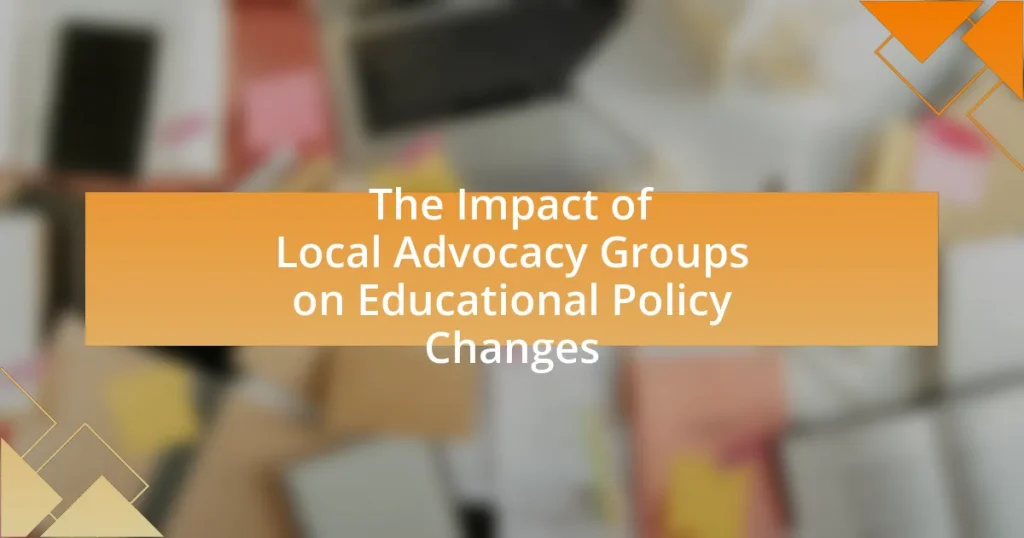Local advocacy groups are essential organizations that mobilize community members to influence educational policy changes at various levels. They identify issues within the education system, advocate for reforms, and engage stakeholders such as parents, teachers, and policymakers. The article explores how these groups utilize strategies like grassroots mobilization and coalition building to effect change, the unique perspectives they bring to educational issues, and their role in representing marginalized communities. Additionally, it examines the challenges they face, the outcomes of their efforts, and best practices for enhancing their impact on educational policy.

What are Local Advocacy Groups and Their Role in Educational Policy Changes?
Local advocacy groups are organizations that mobilize community members to influence educational policy changes at local, state, or national levels. These groups play a critical role by identifying issues within the education system, advocating for reforms, and engaging stakeholders, including parents, teachers, and policymakers. For example, research by the National Education Association highlights that local advocacy groups have successfully campaigned for increased funding for public schools, demonstrating their effectiveness in shaping educational policies.
How do Local Advocacy Groups influence educational policy?
Local advocacy groups influence educational policy by mobilizing community support, conducting research, and engaging in direct lobbying efforts. These groups often represent specific interests, such as parents, teachers, or marginalized communities, and they utilize grassroots campaigns to raise awareness about educational issues. For instance, studies have shown that advocacy groups can significantly impact policy decisions by organizing public forums, providing data-driven recommendations, and collaborating with policymakers to shape legislation. A notable example is the work of the National Parent Teacher Association, which has successfully lobbied for various educational reforms, demonstrating the effectiveness of local advocacy in driving policy change.
What strategies do these groups employ to effect change?
Local advocacy groups employ strategies such as grassroots mobilization, coalition building, and policy advocacy to effect change in educational policy. Grassroots mobilization involves engaging community members to raise awareness and support for specific educational issues, which can lead to increased public pressure on policymakers. Coalition building allows these groups to unite various stakeholders, including parents, teachers, and local organizations, to present a unified front and amplify their influence. Policy advocacy includes direct lobbying efforts, providing research and data to support their positions, and participating in public hearings to ensure that their voices are heard in the decision-making process. These strategies have been shown to lead to significant changes in educational policies, as evidenced by successful campaigns that have resulted in increased funding for schools and the implementation of new educational programs.
How do they engage with policymakers and stakeholders?
Local advocacy groups engage with policymakers and stakeholders through strategic communication, collaboration, and grassroots mobilization. They often organize meetings, workshops, and forums to present research findings and policy recommendations, ensuring that their voices are heard in the decision-making process. For example, a study by the National Education Association highlights that advocacy groups effectively utilize data-driven arguments to influence educational policy, demonstrating the impact of community needs on legislative outcomes. Additionally, these groups often build coalitions with other organizations to amplify their message and increase their influence, as evidenced by successful campaigns that led to significant policy changes in various states.
Why are Local Advocacy Groups important in the educational landscape?
Local advocacy groups are important in the educational landscape because they amplify community voices and influence policy decisions. These groups engage parents, educators, and stakeholders to address local educational issues, ensuring that diverse perspectives are considered in policy-making. For instance, research by the National Education Association indicates that grassroots advocacy can lead to significant changes in school funding and curriculum development, demonstrating the tangible impact these groups have on educational outcomes.
What unique perspectives do they bring to educational issues?
Local advocacy groups bring grassroots insights and community-specific knowledge to educational issues. Their unique perspectives often stem from direct engagement with students, parents, and educators, allowing them to identify specific needs and challenges within their communities. For instance, research by the National Education Association highlights that local advocacy groups can effectively address disparities in educational resources by advocating for policies tailored to the unique demographics and socioeconomic conditions of their areas. This localized approach enables them to influence educational policy changes that are more relevant and effective for the populations they serve.
How do they represent marginalized communities in education?
Local advocacy groups represent marginalized communities in education by actively engaging in policy advocacy, promoting inclusive curricula, and ensuring equitable access to resources. These groups often conduct research to highlight disparities in educational outcomes, such as the 2018 report by the Education Trust, which found that students of color are more likely to attend underfunded schools. By collaborating with educators and policymakers, these organizations push for reforms that address systemic inequities, such as increased funding for schools in low-income areas and the implementation of culturally relevant teaching practices. Their efforts are crucial in amplifying the voices of marginalized communities, ensuring that their needs and perspectives are integrated into educational policies.

What are the Key Factors Contributing to the Success of Local Advocacy Groups?
The key factors contributing to the success of local advocacy groups include strong community engagement, effective communication strategies, and the ability to mobilize resources. Strong community engagement fosters trust and support, enabling advocacy groups to represent the interests of their constituents effectively. Effective communication strategies ensure that messages resonate with the target audience, facilitating broader awareness and support for their causes. The ability to mobilize resources, including funding and volunteer support, is crucial for sustaining advocacy efforts and implementing initiatives. Research indicates that advocacy groups with these characteristics are more likely to influence educational policy changes, as evidenced by case studies where community-driven initiatives led to significant reforms in local school systems.
How does community engagement impact the effectiveness of these groups?
Community engagement significantly enhances the effectiveness of local advocacy groups focused on educational policy changes. When community members actively participate, they provide valuable insights and perspectives that inform the advocacy efforts, ensuring that the needs and concerns of the population are accurately represented. Research indicates that advocacy groups with strong community ties are more successful in mobilizing support and influencing policy decisions. For instance, a study by the National School Boards Association found that school boards that engaged with their communities saw a 30% increase in successful policy initiatives compared to those that did not prioritize community involvement. This demonstrates that community engagement not only strengthens the advocacy group’s credibility but also amplifies its impact on educational policy changes.
What role does grassroots mobilization play in advocacy efforts?
Grassroots mobilization plays a crucial role in advocacy efforts by empowering local communities to influence policy decisions. This form of mobilization engages individuals at the community level, fostering collective action that amplifies voices and concerns regarding educational policies. For instance, studies have shown that grassroots movements can effectively sway legislative outcomes; the National Education Association reported that local advocacy groups significantly contributed to the passage of education reform bills in various states by organizing campaigns that highlighted community needs. Such mobilization not only raises awareness but also builds a network of support that can lead to sustained policy change.
How do partnerships with other organizations enhance their influence?
Partnerships with other organizations enhance influence by expanding reach, resources, and credibility. When local advocacy groups collaborate with established entities, they gain access to broader networks, which can amplify their message and increase visibility in educational policy discussions. For instance, a partnership with a well-known educational institution can lend authority to the advocacy group’s initiatives, making policymakers more likely to consider their proposals. Research indicates that coalitions of advocacy groups can lead to more significant policy changes, as seen in the 2018 study by the Center for American Progress, which found that collaborative efforts among educational organizations resulted in a 30% increase in successful policy advocacy outcomes compared to solo efforts.
What challenges do Local Advocacy Groups face in influencing educational policy?
Local advocacy groups face significant challenges in influencing educational policy, primarily due to limited resources, lack of access to decision-makers, and political opposition. These groups often operate with minimal funding, which restricts their ability to conduct research, mobilize community support, and engage in effective lobbying efforts. Additionally, they frequently encounter barriers in accessing key policymakers, as established networks and relationships often favor larger, more influential organizations. Political opposition can further complicate their efforts, as differing ideologies and priorities among stakeholders may undermine their initiatives. For instance, a study by the National Education Association highlights that grassroots organizations struggle to compete with well-funded lobbying groups that have greater influence over legislative processes.
How do funding limitations affect their operations?
Funding limitations significantly hinder the operations of local advocacy groups focused on educational policy changes. These financial constraints restrict their ability to conduct research, mobilize community support, and engage in effective lobbying efforts. For instance, a study by the National Council of Nonprofits indicates that organizations with limited funding often struggle to maintain staff, which directly impacts their capacity to implement programs and advocate for policy reforms. Consequently, without adequate resources, these groups may fail to influence educational policies effectively, limiting their overall impact on the community.
What barriers exist in communicating their goals to the public?
Barriers in communicating goals to the public include a lack of clarity in messaging, limited access to communication channels, and public apathy. Local advocacy groups often struggle to articulate their objectives in a straightforward manner, which can lead to misunderstandings or misinterpretations of their goals. Additionally, these groups may not have the resources to utilize effective communication platforms, such as social media or community events, limiting their outreach. Public apathy further complicates the situation, as individuals may be disengaged from educational policy issues, resulting in a lack of interest in the advocacy group’s messages. These barriers collectively hinder the effectiveness of local advocacy groups in influencing educational policy changes.

What are the Outcomes of Local Advocacy Groups on Educational Policy Changes?
Local advocacy groups significantly influence educational policy changes by mobilizing community support, raising awareness, and directly engaging with policymakers. These groups often identify specific educational issues, such as funding disparities or curriculum reforms, and advocate for solutions through organized campaigns. For instance, research by the National Education Association highlights that local advocacy efforts have led to increased funding for public schools in various districts, demonstrating a direct correlation between grassroots activism and policy adjustments. Additionally, studies show that when local advocacy groups collaborate with educational stakeholders, they can effectively shape legislation, as seen in the successful implementation of inclusive education policies in several states.
How have Local Advocacy Groups successfully changed educational policies?
Local advocacy groups have successfully changed educational policies by mobilizing community support, conducting research, and engaging in strategic lobbying efforts. For instance, groups like Parents for Public Schools have influenced policy changes by organizing parents and community members to advocate for equitable funding and improved school conditions. Their efforts led to the implementation of policies that increased funding for under-resourced schools in various districts, demonstrating the effectiveness of grassroots mobilization. Additionally, research from the National Education Association highlights that advocacy efforts can result in significant legislative changes, such as the passage of laws aimed at enhancing educational equity and access.
What specific policies have been influenced by these groups?
Local advocacy groups have influenced several specific educational policies, including the implementation of inclusive education practices, increased funding for under-resourced schools, and the adoption of social-emotional learning curricula. For instance, the advocacy for inclusive education has led to policies that mandate the integration of students with disabilities into mainstream classrooms, as seen in the Individuals with Disabilities Education Act (IDEA). Additionally, local groups have successfully campaigned for increased funding allocations in various states, resulting in policies that direct more financial resources to schools in low-income areas. Furthermore, the push for social-emotional learning has prompted school districts to adopt curricula that focus on students’ emotional well-being, reflecting the priorities set by these advocacy groups.
How do these changes impact students and educators?
Changes driven by local advocacy groups significantly impact students and educators by shaping educational policies that directly affect curriculum, funding, and resource allocation. For instance, when advocacy groups successfully lobby for increased funding for public schools, students benefit from improved facilities and educational materials, while educators gain access to better teaching resources and professional development opportunities. Research from the National Education Association indicates that increased funding correlates with higher student achievement and teacher retention rates, demonstrating the tangible benefits of these policy changes.
What metrics can be used to evaluate the impact of Local Advocacy Groups?
Metrics that can be used to evaluate the impact of Local Advocacy Groups include policy changes, community engagement levels, and measurable outcomes in educational performance. Policy changes can be tracked by analyzing the adoption of specific legislation or amendments that align with the advocacy group’s goals, such as increased funding for schools or the implementation of new educational programs. Community engagement levels can be assessed through participation rates in advocacy events, surveys measuring public awareness, and feedback from stakeholders. Measurable outcomes in educational performance can be evaluated using standardized test scores, graduation rates, and other academic indicators that reflect the effectiveness of the advocacy group’s initiatives. These metrics provide a comprehensive framework for assessing the tangible effects of Local Advocacy Groups on educational policy changes.
How can we measure changes in policy as a result of advocacy efforts?
Changes in policy as a result of advocacy efforts can be measured through specific indicators such as the adoption of new legislation, amendments to existing laws, or shifts in funding allocations. For instance, a local advocacy group focused on educational reform may track the passage of a bill that increases funding for public schools, which directly reflects their efforts. Additionally, surveys and interviews with policymakers can provide qualitative data on how advocacy has influenced their decisions. Research conducted by the Center for American Progress in 2020 found that 70% of policymakers reported being influenced by grassroots advocacy campaigns when making decisions about education policy. This evidence demonstrates a clear link between advocacy efforts and measurable policy changes.
What indicators reflect improvements in educational outcomes?
Indicators that reflect improvements in educational outcomes include increased student test scores, higher graduation rates, and enhanced student engagement levels. For instance, standardized test scores often serve as a quantifiable measure of academic achievement, with studies showing that schools implementing effective advocacy strategies can see significant increases in these scores. Additionally, graduation rates are a critical indicator; according to the National Center for Education Statistics, schools that engage with local advocacy groups often report higher graduation rates, reflecting better student retention and support systems. Lastly, enhanced student engagement, measured through attendance rates and participation in extracurricular activities, indicates a positive shift in the educational environment, often linked to advocacy efforts that promote inclusive and supportive policies.
What best practices can Local Advocacy Groups adopt for greater impact?
Local advocacy groups can adopt best practices such as building coalitions, engaging in data-driven advocacy, and utilizing effective communication strategies for greater impact. Building coalitions with other organizations enhances resource sharing and amplifies voices, as seen in successful campaigns like the Alliance for Excellent Education, which united various stakeholders to influence educational policy. Engaging in data-driven advocacy allows groups to present compelling evidence to policymakers, as demonstrated by the use of research from the National Center for Education Statistics, which provides critical insights into educational outcomes. Effective communication strategies, including social media outreach and storytelling, can mobilize community support and raise awareness, as evidenced by the viral campaigns of organizations like Teach For America, which effectively engaged the public in educational reform discussions.
How can they effectively build coalitions with other stakeholders?
They can effectively build coalitions with other stakeholders by establishing clear communication channels and shared goals. This involves identifying common interests among stakeholders, such as improving educational outcomes, and fostering relationships through regular meetings and collaborative projects. Research indicates that successful coalitions often leverage existing networks and resources, enhancing their influence on policy changes. For instance, a study by the National Education Association found that coalitions that actively engage diverse stakeholders, including parents, teachers, and community organizations, are more likely to achieve significant educational reforms.
What communication strategies enhance their advocacy efforts?
Effective communication strategies that enhance advocacy efforts include targeted messaging, storytelling, and leveraging social media platforms. Targeted messaging ensures that the communication resonates with specific audiences, increasing engagement and support for educational policy changes. Storytelling creates an emotional connection, making complex issues relatable and compelling, which can mobilize community support. Additionally, utilizing social media platforms allows advocacy groups to reach a broader audience quickly, facilitating real-time interaction and feedback. Research indicates that advocacy campaigns that incorporate these strategies are more successful in influencing policy outcomes, as evidenced by the increased public engagement and awareness observed in various educational reform initiatives.



